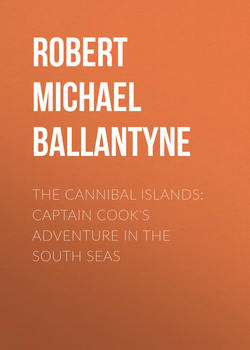Читать книгу The Cannibal Islands: Captain Cook's Adventure in the South Seas - Robert Michael Ballantyne - Страница 4
Chapter Four.
Explains how Coral Islands are made
ОглавлениеSoon after this adventurous visit to the land of Tierra del Fuego, the Endeavour doubled Cape Horn—and entered the waters of the great Pacific Ocean; and now Cook began to traverse those unknown seas in which his fame as a discoverer was destined to be made. He sailed over this ocean for several weeks, however, before discovering any land. It was on Tuesday morning, the 10th of April, that he fell in with the first of the coral islands. Mr Banks’s servant, Peter Briscoe, was the first to see it, bearing south, at the distance of about ten or twelve miles, and the ship was immediately run in that direction. It was found to be an island of an oval form, with a lake, or lagoon, in the middle of it. In fact, it was like an irregularly-formed ring of land, with the ocean outside and a lake inside. Coral islands vary a good deal in form and size, but the above description is true of many of them.
To this island the crew of the Endeavour now drew near with looks of eager interest, as may well be believed, for an unknown land necessarily excites feelings of lively curiosity in the breasts of those who discover it.
It was found to be very narrow in some places, and very low, almost on a level with the sea. Some parts were bare and rocky; others were covered with vegetation, while in several places there were clumps of trees—chiefly cocoa-nut palms. When the ship came within a mile of the breakers, the lead was hove, but no bottom was found with 130 fathoms of line! This was an extraordinary depth so near shore, but they afterwards found that most of the coral islands have great depth of water round them, close outside the breakers.
They now observed that the island was inhabited, and with the glass counted four-and-twenty natives walking on the beach. These all seemed to be quite naked. They were of a brown colour, and had long black hair. They carried spears of great length in their hands, also a smaller weapon, which appeared to be either a club or a paddle. The huts of these people were under the shade of some palm-trees, and Captain Cook says that to him and his men, who had seen nothing but water and sky for many long months, except the dreary shores of Tierra del Fuego, these groves appeared like paradise.
They called this Lagoon Island. As night came on soon after they reached it, however, they were compelled to sail away without attempting to land.
Not long afterwards another island was discovered. This one was in the shape of a bow, with the calm lake, or lagoon, lying between the cord and the bow. It was also inhabited, but Cook did not think it worth his while to land. The natives here had canoes, and the voyagers waited to give them an opportunity of putting off to the ship, but they seemed afraid to do so.
Now, good reader, you must know that these coral islands of the Pacific are not composed of ordinary rocks, like most other islands of the world, but are literally manufactured or built by millions of extremely small insects which merit particular notice. Let us examine this process of island-making which is carried on very extensively by the artisans of the great South-Sea Factory!
The coral insect is a small creature of the sea which has been gifted with the power of “secreting” or depositing a lime-like substance, with which it builds to itself a little cell or habitation. It fastens this house to a rock at the bottom of the sea. Like many other creatures the coral insect is sociable; it is fond of company, and is never found working except in connection with millions of its friends. Of all the creatures of earth it shows perhaps the best example of what mighty works can be accomplished by union. One man can do comparatively little, but hundreds of men, united in their work, can achieve wonders, as every one knows. They can erect palaces and cathedrals towering to the skies; they can cover hundred of miles of ground with cities, and connect continents with telegraphs, but, with all their union, all their wisdom, and all their power, men cannot build islands—yet this is done by the coral insect; a thing without hand or brain, a creature with little more than a body and a stomach. It is not much bigger than a pin-head, yet hundreds of the lovely, fertile islands of the Pacific Ocean are formed by this busy animalcule. Many of those islands would never have been there but for the coral insect!
